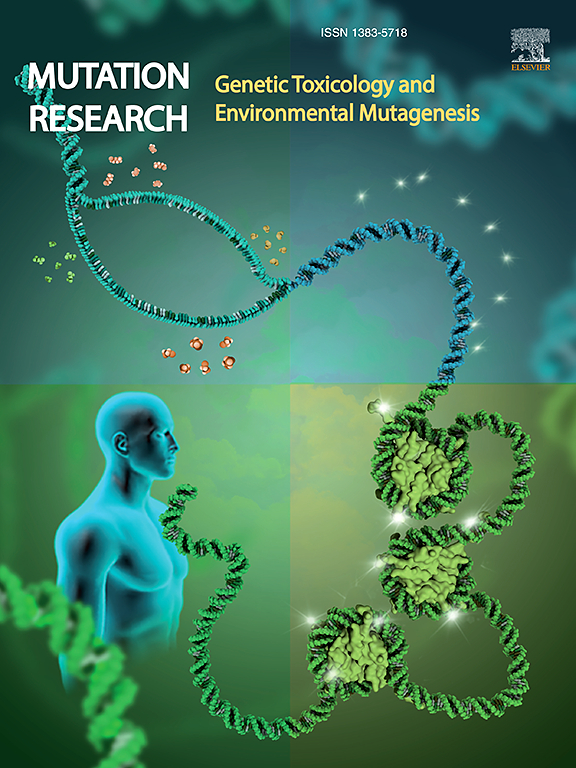Genotoxic and cytotoxic effects of polystyrene nanoplastics on human lymphocytes: A comprehensive analysis
IF 2.5
4区 医学
Q3 BIOTECHNOLOGY & APPLIED MICROBIOLOGY
Mutation research. Genetic toxicology and environmental mutagenesis
Pub Date : 2025-02-01
DOI:10.1016/j.mrgentox.2025.503850
引用次数: 0
Abstract
A growing amount of plastic waste is finding its way into natural ecosystems as a result of the widespread usage of plastics in modern society. These wastes degrade physically and biologically over time, transforming into microplastics (MPs) and nanoplastics (NPs). MPs and NPs emissions from the terrestrial environment then mix with rivers and eventually the seas, forming garbage. The cytotoxic and genotoxic effects of 50 nm polystyrene nanoplastics (PsNP) on human lymphocytes were assessed using the in vitro mitotic index (MI), micronucleus (MN), and comet assays. Both 24 and 48-h applications were performed for MI, and it was determined that 50 nm PsNP provided a statistically significant decrease in MI compared to the control at all concentrations and application times (except 0.001 and 0.1 μg/mL at 24 h). According to the MN test results, the MN frequency increased significantly at all concentrations when compared to the negative control. In the comet test, a statistically significant increase of comet tail length was observed at 0.001, 10 and 100 μg/mL concentration with 50 nm PsNP exposure. Tail moment also showed a statistically significant increase at the lowest concentration of 0.001 μg/mL and the highest concentration of 1, 10, 100 μg/mL compared to the negative control. All test results show that PsNP has both genotoxic and cytotoxic potential.
聚苯乙烯纳米塑料对人淋巴细胞的遗传毒性和细胞毒性:综合分析
由于塑料在现代社会的广泛使用,越来越多的塑料垃圾正在进入自然生态系统。随着时间的推移,这些废物会发生物理和生物降解,转化为微塑料(MPs)和纳米塑料(NPs)。从陆地环境中排放出来的MPs和NPs与河流混合,最终进入海洋,形成垃圾。采用体外有丝分裂指数(MI)、微核(MN)和彗星(comet)试验评估50 nm聚苯乙烯纳米塑料(PsNP)对人淋巴细胞的细胞毒性和基因毒性作用。在24和48小时的应用中,研究人员发现,与对照组相比,在所有浓度和应用时间下,50 nm PsNP均能显著降低心肌梗死(24 小时0.001和0.1 μg/mL除外)。MN检测结果显示,与阴性对照相比,在所有浓度下,MN频率均显著增加。在彗星试验中,浓度为0.001、10和100 μg/mL、暴露于50 nm的PsNP时,彗尾长度增加具有统计学意义。尾矩在最低浓度为0.001 μg/mL和最高浓度为1、10、100 μg/mL时也较阴性对照有统计学意义的增加。所有测试结果表明PsNP具有基因毒性和细胞毒性潜能。
本文章由计算机程序翻译,如有差异,请以英文原文为准。
求助全文
约1分钟内获得全文
求助全文
来源期刊
CiteScore
3.80
自引率
5.30%
发文量
84
审稿时长
105 days
期刊介绍:
Mutation Research - Genetic Toxicology and Environmental Mutagenesis (MRGTEM) publishes papers advancing knowledge in the field of genetic toxicology. Papers are welcomed in the following areas:
New developments in genotoxicity testing of chemical agents (e.g. improvements in methodology of assay systems and interpretation of results).
Alternatives to and refinement of the use of animals in genotoxicity testing.
Nano-genotoxicology, the study of genotoxicity hazards and risks related to novel man-made nanomaterials.
Studies of epigenetic changes in relation to genotoxic effects.
The use of structure-activity relationships in predicting genotoxic effects.
The isolation and chemical characterization of novel environmental mutagens.
The measurement of genotoxic effects in human populations, when accompanied by quantitative measurements of environmental or occupational exposures.
The application of novel technologies for assessing the hazard and risks associated with genotoxic substances (e.g. OMICS or other high-throughput approaches to genotoxicity testing).
MRGTEM is now accepting submissions for a new section of the journal: Current Topics in Genotoxicity Testing, that will be dedicated to the discussion of current issues relating to design, interpretation and strategic use of genotoxicity tests. This section is envisaged to include discussions relating to the development of new international testing guidelines, but also to wider topics in the field. The evaluation of contrasting or opposing viewpoints is welcomed as long as the presentation is in accordance with the journal''s aims, scope, and policies.

 求助内容:
求助内容: 应助结果提醒方式:
应助结果提醒方式:


